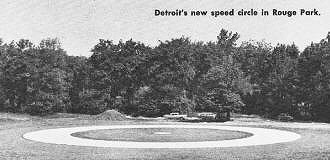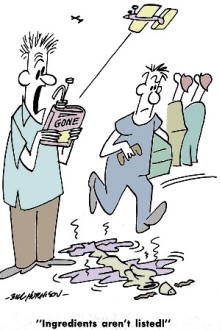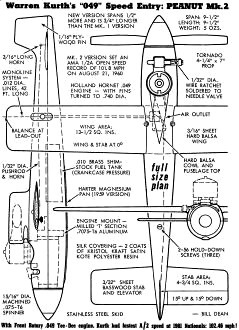|
Per "Wild Bill" Netzenband's
report in this 1961 issue of American Modeler magazine covered the Vancouver
Bi-Liners, MAC highlights, Alan Nichols' success in Thompson Trophy Racer events,
encouraging clubs to adopt the affordable, and slow-flying contests. He addresses
backlogged club crest submissions, noting the impracticality of featuring all due
to volume. Alan Nichols debunks the myth that models wear out quickly, citing his
year-old Nobler and a five-year-old Fierce Arrow with original engine. Memories
resurface of McDonnell Aircraft's picnic air shows, where Phil Hamm's reliable metal
jet stood out. Southern California's new Control-Line Association, led by John Gudvangan
and others, seeks enthusiasts. Detroit's Metropolitan Speed Association unveils
an $8,000 Rouge Park speed circle, aiming for a competitive circuit. Warren Kurth
praises the Magician 15 kit and Tee Dee 15 engine for stunt performance, advocating
compact designs. Combat suggestions include longer lines for slower, predictable
maneuvers. Pioneer Mfg. discontinues high-strength screws due to production issues,
though standard screws remain viable. GAB.AI
Wild Bill Netzeband's Control Line Capers

Detroit's new speed circle in Rouge Park.
The Vancouver Bi-Liners MAC "Bi-Line" tells us that the Thompson Trophy Racers
(July 1961 AM) are catching on there. Seems Alan Nichols has things his way in the
event. They plan other contests for it and you might do well to try some in your
club. Lots of fun for a little money and the ships are slow enough to enjoy operations.
Shower of Emblems
The boss suggested some space be devoted to explaining to irate clubs, that AM
receives thousands of letters on just about everything each month and that they
have on hand right now several hundred club crests and descriptions. Since there
are exactly 12 regular issues and an Annual or two, obviously only a few of them
can be used. Acknowledgment of each individual letter is also impractical, so be
patient. Sometimes we can lose sight of the fact that there are a million of us
interested in models. When we all start funneling info into a magazine, it must
snow letters!
Worn Out?
A further point from the June Bi-Liner, by Alan Nichols, contends "common notion
that all models are worn out after 6 months, is untrue." Right! He has a year old
Nobler still flying. Me, I just retired the original Fierce Arrow after some 5 years'
service. The cowl fell off and simply cannot be reglued. Have had three sets of
controls (each time they failed in the air) and many flights. Same old Fox through
whole life, and the engine is now 8 years old. Just getting broken in? With good
care, and solid construction they can go on and on.
 Memories Memories
Reading Bill Johnson's account of the McDonnell Aircraft Comany's picnic Air
Show in the Tri City Steelers "Bulletin" (St. Louis Area), brought back a flood
of memories. Your reporter was in about 6 of them from 1951 thru 1957. Each year
Phil Hamm flew his Jet. He did it this year too. An all metal job (maybe a new one)
it always ran without the usual tank trouble. We were speaking of longevity, he's
really got it. That one hour demonstration is a real pressure suit. Used to get
18 flights and as many as 25 planes in the air during them. See Gil Frankenburg
is still in there. Used to have 10,000 people wandering around on picnic days.
Southern Calif. Control-Line Assn
Just formed and rolling, Jack Fox, editor of the Newsletter, provides info. Such
names as John Gudvangan - Pres., Bob Haren - Vice., John Barr - Sec., and Ralph
Cozad - Treas., indicate this will be a real comer group. Also notice that Art Palowski
is out there now, still winning stunt in Xpert class. Jack asks anyone interested
in their affairs to drop him a note at 4708 N. Arden Dr., El Monte, Calif.
Detroit's new speed circle in Rouge Park.
Detroit Area-Metropolitan Speed Association
George Blass sent pies and info about the newly organized MSA. Such a beautiful
circle deserves record performances. This seems an example of satisfactory liaison
with city officials. The circle itself ran $8,000 and the area surrounding can hold
six 60' circles. The Strathmoor group and specifically Harold Saincome, VP, built
the fire under park officials. The MSA is shooting for an organized speed circuit,
and with this momentous start might just do it.
Contact George at 921 N. Drexel; Dearborn, Mich. Also says CL activity in general
is increasing. Speed is definitely coming up. All healthy signs.

Warren Kurth's "049" Speed Entry: Peanut Mk.2
Magician 15 & The Tee Dee 15
Product test this time is the Technical Model Products "Magician 15." The kit
is excellent with rock hard, die-cut fuse and good wood throughout. Plans are clear
and cover most points well. Went together nicely. First flights were with a Super
Tigre Jubilee. I know it can't be done, but had to try. The engine is heavy (6-oz)
so needed 1-oz lead in rear for balance. The CG shown is exactly right and any other
hurts performance. Wing loading is rather high, resulting in wide smooth turns,
but then it is a trainer and holding speed up helps the tyro.
The ST engine had trouble forgetting it is a bored-out racer, so replaced it
with a Tee Dee 15. Such a pretty engine. It, too, is timed for racing and FAI power,
but when I finally ran it peaked all the time, it worked perfectly throughout the
pattern. Running TD racing fuel, found it a little more tolerant with the Olympic
head. If you want a good stunt 15 engine, be sure to try this one. It's a power
house.
After unflapped tests, we hinged the flaps, as suggested on the plans. This makes
a whale of a difference. Now, squares and hourglass are a breeze. Full pattern,
no sweat. Using 60 foot .010 lines, took the 3/4-oz tip weight out. With AYSC lines,
leave it in. Oh, flap and elevator were moved thru the same angle of about 30 degrees
(1:1 ratio). All up weight is 17-oz with 5 coats of Aero Gloss and Silk-span covering.
Am becoming more convinced that compact stunt has a real place in things. What
else will give you 12 full pattern flights on a pint of fuel?
Calm Combat?
How about using 70' lines in Combat? Slow down angular speeds, give more maneuvering
room and make things more predictable. Since cutting engine size is unfair to manufacturers,
the long lines should solve reaction time problems. Think it over.
Also, annudder thought. The engine men are now using ball and needle bearings
to satisfy our urge for power and speed. What sense this? Precision bearings are
assembled to fantastic tolerances in the millionths of an inch, and under extremely
clean conditions. So where do we land them? Pow, in the dirt. The new Johnson BB
36 uses 2 precision instrument bearings and out of the box will turn over from only
piston weight. Smooth. Am breaking it in and will report later.
Screws Cooled
Pioneer Mfg. Co., makers of the "Equalizer," have informed me that the manufacturer
of the high strength screws has backed down. Reason, too many government contracts
and difficulties in production. So, regretfully, Pioneer must leave out that feature.
They say the rest of the kit will remain at same and even better quality. My tests
show that commercial grade screws in the non-plated condition are fairly good. Trouble
is the wide variation in quality due to lack of rigid requirements. Allen and Unbrako
make high strength screws, but they have Hex recess heads.
|


